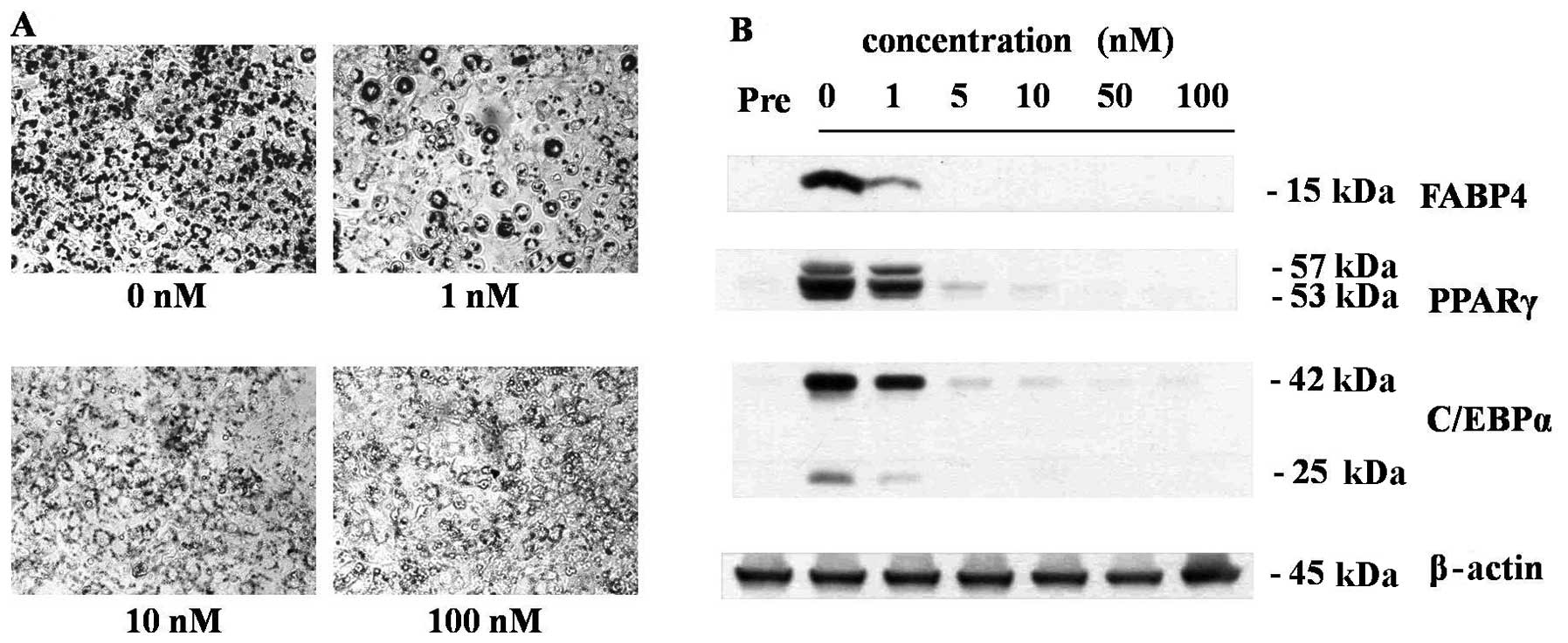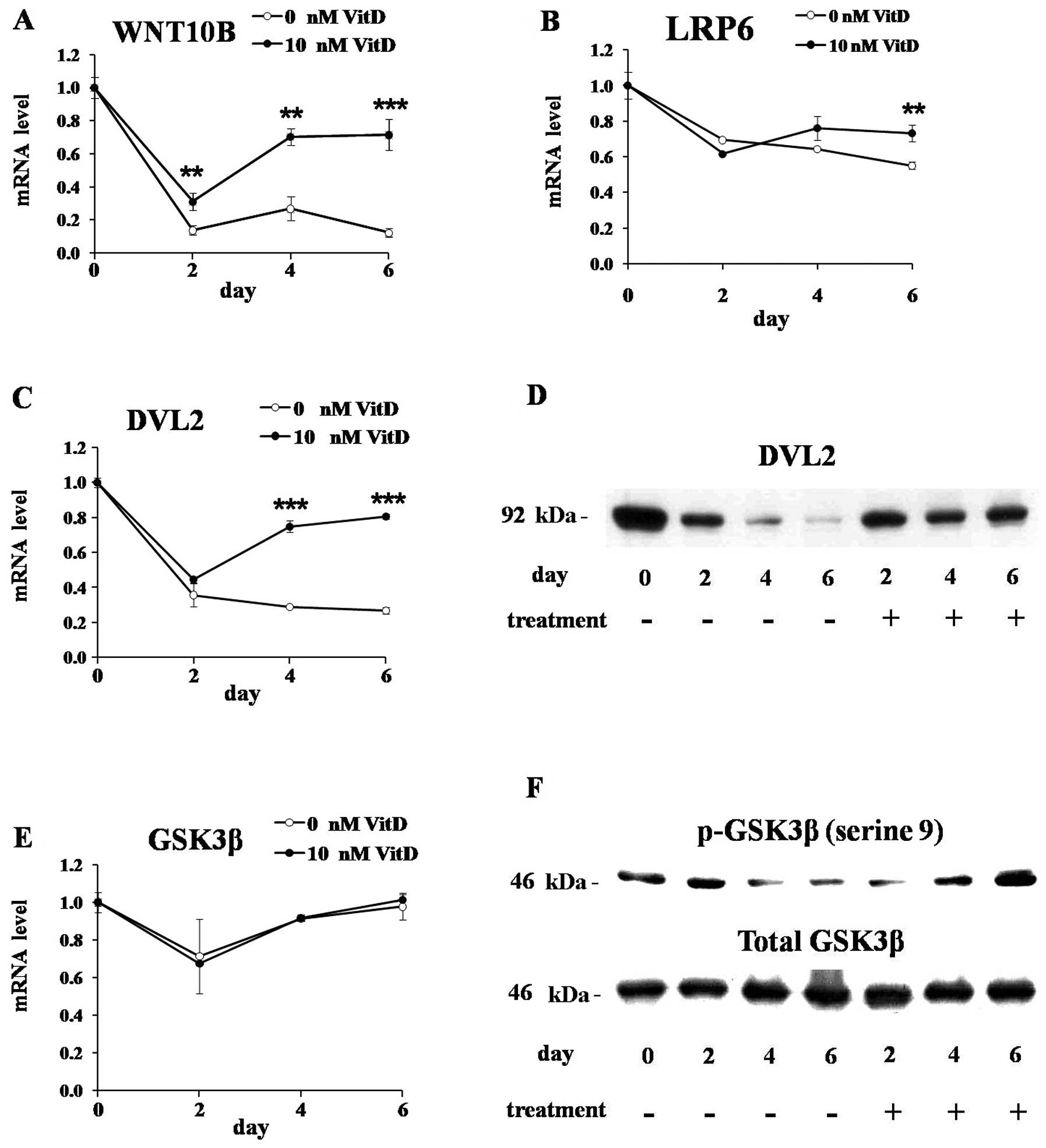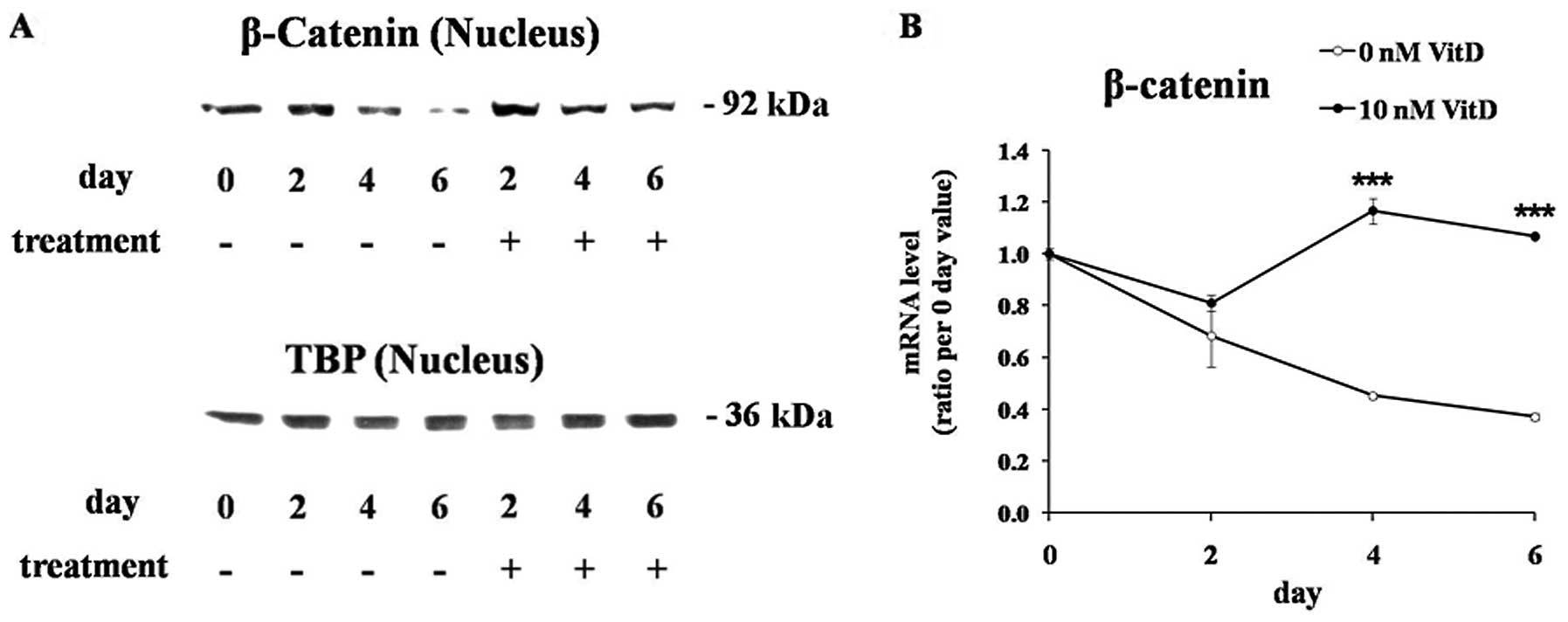Anti-adipogenic effects of 1,25-dihydroxyvitamin D3 are mediated by the maintenance of the wingless-type MMTV integration site/β-catenin pathway
- Authors:
- Published online on: August 20, 2012 https://doi.org/10.3892/ijmm.2012.1101
- Pages: 1219-1224
Abstract
Introduction
Obesity is a serious health problem worldwide, because it is a major risk factor for type 2 diabetes, hypertension, cardiovascular disease, and cancer (1). Overaccumulation of adipose tissue is the fundamental phenomenon of obesity (2,3). Therefore, the understanding of the molecular mechanisms underlying adipose tissue formation, i.e., adipogenesis, is required for the effective prevention and treatment of obesity. Adipogenesis is a complex process accompanying the differentiation of preadipocytes into adipocytes followed by the intracellular fat accumulation (4–6). 3T3-L1 preadipocyte has been used as an in vitro model of adipogenesis for decades (7), and its adipogenic differentiation was mediated by the upregulations of peroxisome proliferator-activated receptor (PPAR)γ and CCAAT/enhancer binding protein (C/EBP)α followed by the inductions of lipid metabolizing enzymes such as fatty acid binding protein (FABP)4, lipoprotein lipase (LPL) and fatty acid synthase (4–6).
Vitamin D is produced from 7-dehydrocholesterol in the skin by ultraviolet radiation and converted in the liver to 25-hydroxyvitamin D, followed by its conversion to 1,25-dihydroxyvitamin D3 (1,25(OH)2D3) in kidney and other tissues. 1,25(OH)2D3, the bioactive form of vitamin D, plays multiple physiological roles including the maintenance of calcium and phosphorus levels for bone homeostasis (8). Accumulating evidence suggests that a potential link exists between vitamin D deficiency and obesity in human population (9), and vitamin D deficiency was proposed as one of the causes of common obesity (10). Anti-obesity effect of vitamin D was suggested by the finding that 1,25(OH)2D3 efficiently inhibit adipogenesis at nanomolar concentration (11). 1,25(OH)2D3, the bioactive form of vitamin D, was found to inhibit the adipogenesis of 3T3-L1 cells and primary cultures of mouse epididymal fat (12). It is necessary to understand the anti-adipogenic mechanism of vitamin D for the effective prevention and treatment of obesity, however, the molecular mechanism for the anti-adipogenic effect of 1,25(OH)2D3 was not fully elucidated until now.
As a possible candidate of the mediator for the anti-adipogenic effect of vitamin D, we focused on the wingless-type MMTV integration site (WNT)/β-catenin pathway. The WNT/β-catenin pathway is known to be involved in various cellular processes such as differentiation, development, proliferation and tumorigenesis (13–15). Recently, an additional function of the WNT/β-catenin pathway was identified: the negative regulator of adipogenesis (16,17). When the WNT/β-catenin pathway is inactive, β-catenin is proteasomally degraded by the destruction complex composed of adenomatous polyposis coli (APC), glycogen synthase kinase (GSK)3β and AXIN. Activation of the WNT/β-catenin pathway enhances the interaction between disheveled (DVL)s and AXIN. Consequently, the APC-GSK3β-AXIN destruction complex is disrupted, thereby increasing stabilization and nuclear translocation of β-catenin (18,19). In the nucleus, β-catenin induces the expression of cyclin D1, c-Myc and PPARδ, which have been reported to inhibit PPARγ, a major adipogenic transcription factor (20–23). Until now, no study reported the association between the anti-obesity effects of vitamin D and the WNT/β-catenin pathway. In this study, we found that the anti-adipogenic effect of 1,25(OH)2D3 was accompanied by the maintenance of the WNT/β-catenin pathway signaling, which was normally downregulated during adipogenesis.
Materials and methods
Chemicals and reagents
Cell culture reagents were obtained from Life Technologies Inc. (Grand Island, NY, USA). Anti-PPARγ, anti-FABP4, anti-phospho-GSK3β and anti-GSK3β antibodies and secondary antibody were obtained from Cell Signaling (Beverly, MA, USA). Anti-C/EBPα, anti-DVL2, anti-β actin and anti-TBP antibody were purchased from Santa Cruz Biotechnology, Inc. (Santa Cruz, CA, USA). Anti-β-catenin antibody was purchased from BD Transduction Laboratories (Lexington, KY, USA). All other chemicals including 1,25(OH)2D3 were purchased from Sigma-Aldrich (St. Louis, MO, USA).
Cell culture and differentiation
3T3-L1 preadipocytes were purchased from the American Type Culture Collection (Manassas, VA, USA) and were subcultured every 2 or 3 days. The cells were seeded in 6-well plates at a density of 1.5×105 cells/well. Two days after reaching confluence (day 0), the 3T3-L1 cells were differentiated in Dulbecco’s modified Eagle’s medium (DMEM) containing 1 μg/ml insulin, 0.25 μM dexamethasone, 0.5 mM 3-isobutyl-1-methylxanthine and 10% fetal bovine serum (differentiation-induction medium) for 2 days. The cells were then maintained in DMEM containing 1 μg/ml insulin and 10% fetal bovine serum (differentiation maintenance medium). The differentiation maintenance medium was changed every 2 days until the cells were harvested. To test its effects on adipo-genesis, 1,25(OH)2D3 was added to the differentiation induction medium and differentiation maintenance medium until the cells were harvested. Lipid droplets in the cells were stained with Oil Red O as previously described (24).
Real-time polymerase chain reaction (PCR)
Cells were harvested, and total RNA was extracted using an RNeasy kit (Qiagen, Hilden, Germany). One microgram of total RNA was reverse-transcribed at 37°C using the cDNA Reverse Transcription kit (Applied Biosystems, Inc., Foster City, CA, USA). Briefly, the reaction was performed in a final volume of 20 μl, which included reverse transcriptase reaction buffer, 100 mM dNTP mix, random primers, MultiScribe™ Reverse Transcriptase, RNase inhibitor and total RNA. The reaction mixtures were heated at 25°C for 10 min, 37°C for 120 min and 85°C for 5 min. Real-time PCR was performed using the 7000 Real-Time PCR system (Applied Biosystems) in a final volume of 20 μl, which included TaqMan gene expression master mix, 250 nM of TaqMan probe, an optimized concentration of each primer, and 2 μl of the reverse transcription product containing cDNA. The reaction mixtures were preheated at 95°C for 10 min to activate the enzyme and then subjected to 40 cycles of melting at 95°C for 15 sec and annealing/extension at 60°C for 1 min. The assay-on-demand gene expression products (Applied Biosystems, Inc.) were used to evaluate the mRNA levels of PPARγ (Mm00440945_m1), C/EBPα (Mm01265914_ s1), FABP4 (Mm00445880_m1), LPL (Mm00434764_m1), WNT10B (Mm00442104_m1), LRP6 (Mm00999795_m1), DVL2 (Mm00432899_m1), GSK3β (Mm00444911_m1) as well as the level of 18S rRNA (Hs99999901_s1). The 18S rRNA was used as an internal control as previously described (25). For each sample, the mRNA level was normalized against the level of 18S rRNA, and the ratio of normalized mRNA to the preadipocytes (day 0) was determined using the comparative Ct method (26).
Protein extraction and western blotting
Cells were harvested using a cell scraper and lysed with ice-cold RIPA buffer containing 25 mM Tris-HCl (pH 7.6), 150 mM NaCl, 1% Nonidet P-40, 1% sodium deoxycholate, 0.1% SDS and a protease inhibitor cocktail (Sigma-Aldrich) to obtain total cell lysates. The total cell lysates were then centrifuged at 20,000 × g for 20 min at 4°C to remove the insoluble materials. The protein concentrations were determined using a BCA protein assay kit (Pierce, Rockford, IL, USA). Fifty micrograms of each protein extract was separated using 12% polyacrylamide gel electrophoresis and electrotransferred to nitrocellulose membranes at 150 mA for 1 h. The membranes were then blocked for 2 h at room temperature with phosphate buffered saline containing 5% skim milk and 0.1% Tween-20, and incubated with 1:1,000-dilutions of primary antibody overnight at 4°C followed by a 1:1,000-dilution of horseradish peroxidase-conjugated secondary antibody for 1 h at room temperature. Peroxidase activity was visualized using an ECL kit (Pierce). β-actin was used as a loading control for cytosolic proteins.
Analysis of nuclear β-catenin level
Cells were harvested using a cell scraper and then nuclear extracts were prepared using a nuclear extract kit (Active Motif, Carlsbad, CA, USA). Protein concentrations in the nuclear extracts were determined using a BCA protein assay kit (Pierce). Ten micrograms of nuclear protein were separated using 12% polyacrylamide gel electrophoresis and analyzed by western blotting using an anti-β-catenin antibody followed by a secondary antibody. TATA-box binding protein (TBP) was used as a loading control for nuclear proteins.
Statistical analysis
All data are expressed as means ± standard deviations from at least three replicate experiments. Statistically significant differences between treated and untreated samples were detected using an unpaired t-test. All analyses were performed using SPSS ver. 19 (SPSS, Chicago, IL, USA).
Results
Inhibitory effects of 1,25(OH)2D3 on the adipogenesis of 3T3-L1 cells
As shown in Fig. 1, treatments of nanomolar concentrations of 1,25(OH)2D3 during the adipogenesis of 3T3-L1 cells effectively inhibited the adipogenesis of 3T3-L1 cells in a dose-dependent manner. At the concentration of 10 nM, 1,25(OH)2D3 completely inhibited lipid droplet formation (Fig. 1A) as well as the expressions of adipocyte maker protein, FABP4, PPARγ and C/EBPα (Fig. 1B). Because 10 nM is the optimal anti-adipogenic concentration of 1,25(OH)2D3, all further experiments were conducted at this concentration. In time-course experiments, 1,25(OH)2D3 treatment significantly suppressed the mRNA expression of major transcription factors of adipogenesis, PPARγ and C/EBPα, as well as the proteins involved in lipid metabolism, FABP4 and LPL (Fig. 2A). The protein expression was also suppressed by 1,25(OH)2D3 showing similar patterns with mRNA expression (Fig. 2B).
Maintenance of the WNT signaling by 1,25(OH)2D3
To investigate the effects of 1,25(OH)2D3 on the WNT signaling, we measured the expressions of the genes involved in the WNT signaling in 3T3-L1 cells differentiated for 0, 2, 4 and 6 days in the presence or absence of 1,25(OH)2D3. The mRNA level of WNT10B was markedly downregulated during adipogenesis of untreated cells, but the treatment of 1,25(OH)2D3 maintained its expression levels (Fig. 3A). The mRNA level of LRP6 was mildly decreased during adipogenesis of untreated cells, but 1,25(OH)2D3 maintained its level (Fig. 3B). DVL2 is reported to be activated by WNT signaling and prevent the formation of the APC-GSK3β-AXIN destruction complex which degrade β-catenin (27). The mRNA and protein levels of DVL2 were markedly downregulated during adipogenesis of untreated cells, but 1,25(OH)2D3 maintained their mRNA and protein levels during adipogenesis (Fig. 3C and D). During adipogenesis of 3T3-L1 cells, treated or untreated, the mRNA and protein levels of GSK3β were not significantly changed (Fig. 3E and F, lower panel), but its phosphorylation on serine 9 residue was significantly decreased in untreated cells (Fig. 3F, upper panel). 1,25(OH)2D3 efficiently elevated GSK3β phosphorylation even though it has no effects on total GSK3β protein levels as well as its mRNA levels. GSK3β is a component of APC-GSK3β-AXIN destruction complex which is involved in the proteolytic degradation of β-catenin, and it is also well-known that GSK3β is inactivated by its phosphorylation (15,19). We found that GSK3β was activated by its dephosphorylation during adipogenesis of untreated 3T3-L1 cells, but the treatment of 1,25(OH)2D3 efficiently elevated its phosphorylation levels resulting in its inactivation.
Maintenance of nuclear β-catenin levels by 1,25(OH)2D3
β-catenin is a transcriptional cofactor which plays a central role in the WNT/β-catenin pathway (20). The nuclear level of β-catenin protein was significantly reduced during adipogenesis of untreated cells, but 1,25(OH)2D3 treatment maintained the nuclear β-catenin levels (Fig. 4A). TBP protein was used as an endogenous control for the loading of equal amounts of the nuclear protein. The levels of the β-catenin mRNA, which were significantly downregulated during the adipogenesis of untreated cells, were also maintained by 1,25(OH)2D3 treatment (Fig. 4B).
Discussion
The effects of vitamin D on WNT signaling in relation to adipo-genesis were not reported until now. The relation of vitamin D and WNT signaling has only been reported in relation to cancer: vitamin D was reported to have a protective effect against colorectal cancer by its inhibitory action on the WNT/β-catenin pathway (28). In the present study on the anti-adipogenic mechanisms of vitamin D, our interest in the WNT/β-catenin pathway was prompted by recent findings of its role as a negative regulator of adipogenesis (16,17). WNT signaling was reported to inhibit adipogenesis (29), and was found to mediate the anti-adipogenic effects of some cytokines and chemical compounds: anti-adipogenic cytokines, tumor necrosis factor α and interleukin-6 inhibit adipogenesis by the activation of WNT signaling (25). Bisindoylmaleimide I, a specific inhibitor of protein kinase C, inhibits adipocyte differentiation through the activation of the WNT signaling (30), and curcumin, a component of curry, inhibits adipogenesis via the WNT/β-catenin pathway (31).
In this study, the induction of PPARγ, a major transcription factor of adipogenesis, was effectively suppressed by 1,25(OH)2D3 (Figs. 1 and 2), while the nuclear level of β-catenin was maintained by 1,25(OH)2D3 during the adipogenesis of 3T3-L1 cells (Fig. 4A). It is well-known that the WNT singling upregulates β-catenin at post-translation levels by protein stabilization (18,19). Few reports exist on the transcriptional regulation of β-catenin during adipogenesis, and it is interesting that 1,25(OH)2D3 also maintained mRNA levels of β-catenin which were decreased during adipogenesis of untreated cells (Fig. 4B). Even though further study is necessary to elucidate the transcriptional modulation of β-catenin by 1,25(OH)2D3, these experimental data can provide an explanation for the anti-adipogenic mechanism of 1,25(OH)2D3, considering that β-catenin inhibits PPARγ directly (32), and indirectly by inducing its target genes (21–23). Our data suggest that the anti-adipogenic effect of 1,25(OH)2D3 is mediated by the maintenance of the nuclear β-catenin levels, which results in the suppression of PPARγ, the major adipogenic transcription factor playing a central role in the expressions of lipid-metabolizing enzymes (4–6,33).
Among members of WNT family, WNT10B is most closely related to adipogenesis and obesity, and previous studies have established the role of WNT10B as an endogenous regulator of adipogenesis (34). WNT10B transgenic mice which express WNT10B from the adipocyte-specific promoter, showed 50% reduction of the total body fat and resisted the accumulation of adipose tissue when fed a high fat diet (35). Human obesity phenotype in various populations were reported to be associated with the genetic polymorphisms of WNT10B (36,37). In the present study, it was found that 1,25(OH)2D3 maintained the expression level of WNT10B, a WNT family member most closely related to adipogenesis and obesity (Fig. 3A).
In conclusion, 1,25(OH)2D3 maintained WNT10B expression levels resulting in the maintenance of the nuclear levels of β-catenin which is a suppressor of adipogenesis, suggesting that the WNT/β-catenin pathway plays a role as a mediator for the anti-adipogenic and anti-obesity effects of vitamin D.
Abbreviations:
|
APC |
adenomatous polyposis coli; |
|
C/EBP |
CCAAT/enhancer binding protein; |
|
DVL |
disheveled; 1,25(OH)2D3, 1,25-dihydroxyvitamin D3; |
|
FABP |
fatty acid binding protein; |
|
GSK |
glycogen synthase kinase; |
|
LPL |
lipoprotein lipase; |
|
LRP |
low density lipoprotein receptor-related protein; |
|
PPAR |
peroxisome proliferator-activated receptor; |
|
WNT |
wingless-type MMTV integration site |
Acknowledgements
This study was supported by the Basic Science Research Program through the National Research Foundation of Korea (NRF) funded by the Ministry of Education, Science and Technology (2010-0007729).













